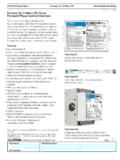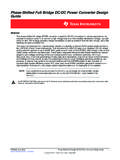Transcription of AN149 Modeling and Loop Compensation Design of …
1 Application Note 149AN149-1an149faJanuary 2015 IdentIfyIng the ProblemA well-designed switching mode power supply (SMPS) must be quiet, both electrically and acoustically. An under-compensated system may result in unstable operations. Typical symptoms of an unstable power supply include: audible noise from the magnetic components or ceramic capacitors, jittering in the switching waveforms, oscillation of output voltage , overheating of power FETs and so on. However, there are many reasons that can cause undesir-able oscillation other than loop stability. Unfortunately, they all look the same on the oscilloscope to the inexperienced supply designer. Even for experienced engineers, some-times identifying the reason that causes the instability can be difficult. Figure 1 shows typical output and switching node waveforms of an unstable buck supply.
2 Adjusting the loop Compensation may or may not fix the unstable supply because sometimes the oscillation is caused by other factors such as PCB noise. If you do not have a list of possibilities in your mind, uncovering the underlying cause of noisy operation can be very time-consuming and frustrating. figure 1. typical output voltage and Switching node Waveforms of an Unstable buck ConverterIntrodUCtIonToday s electronic systems are becoming more and more complex, with an increasing number of power rails and supplies. To achieve optimum power solution density, reliability and cost, often system designers need to Design their own power solutions, instead of just using commer-cial power supply bricks. Designing and optimizing high performance switching mode power supplies is becoming a more frequent and challenging task.
3 Power supply loop Compensation Design is usually viewed as a difficult task, especially for inexperienced supply designers. Practical Compensation Design typically involves numerous iterations on the value adjustment of the Compensation components. This is not only time consuming, but is also inaccurate in a complicated system whose supply bandwidth and stability margin can be affected by several factors. This application note explains the basic concepts and methods of small signal Modeling of switching mode power supplies and their loop Compensation Design . The buck step-down converter is used as the typical example, but the concepts can be applied to other topologies. A user-friendly LTpowerCADTM Design tool is also introduced to ease the Design and optimization.
4 Modeling and Loop Compensation Design of Switching Mode Power SuppliesHenry J. s/DIVVO50mV/DIVVSW10V/DIV200ns/DIVVSW10V /DIVAN149 F01L, LT, LT C, LT M, Linear Technology, the Linear logo and LTspice are registered trademarks and LTpowerCAD is a trademark of Linear Technology Corporation. All other trademarks are the property of their respective Note 149AN149-2an149faFor switching mode power converters, such as an LT C 3851 or LTC3833 current -mode buck supply shown in Figure 2, a fast way to determine whether the unstable operation is caused by the loop Compensation is to place a large, F, capacitor on the feedback error amplifier output pin (ITH) to IC ground. (Or this capacitor can be placed between the amplifier output pin and feedback pin for a voltage mode supply.)
5 This F capacitor is usually considered large enough to bring down the loop bandwidth to low frequency, therefore ensuring voltage loop stability. If the supply becomes stable with this capacitor, the problem can likely be solved with loop Compensation . An over-compensated system is usually stable, however, with low bandwidth and slow transient response. Such Design requires excessive output capacitance to meet the transient regulation requirement, increasing the overall supply cost and size. Figure 3 shows typical output volt-age and inductor current waveforms of a buck converter during a load step up/down transient. Figure 3a is for a stable but low bandwidth (BW) over-compensated system, where there is large amount of VOUT undershoot/over-shoot during transient.
6 Figure 3b is for a high bandwidth under-compensated system, which has much less VOUT undershoot/overshoot but the waveforms are not stable in steady state. Figure 3c shows the load transient of a well-designed supply with a fast and stable loop. VOUTVOUTVINTGSWVFBITHFREQGNDBGSENSE+SENS E F02figure 2. A typical buck Step-down Converter (ltC3851, ltC3833, ltC3866, etc.)Application Note 149AN149-3an149fa (V) (A)18146 2102 6 TIME ( s)348448AN149 F03a480416464400432 VOUTIOUTIL (V) (A)182 15 TIME ( s)385441AN149 F03b413455399427 VOUTIOUTIL a) lower bandwidth and Stable b) higher bandwidth but Unstable (V) (A)18156 3120 993 6 TIME ( s)385441AN149 F03c413455399427 VOUTIOUTILc) optimum Design with fast and Stable loopfigure 3. typical load transient responses of a) An over-Compensated System; b) An Under-Compensated System; c) optimum Design with a fast and Stable loopApplication Note 149AN149-4an149fadiode D can be replaced by a synchronous FET, which is still a passive switch.
7 The active terminal a is the active switch terminal. The passive terminal p is the passive switch terminal. In a converter, the terminals a and p are always connected to a voltage source, such as VIN and ground in the buck converter. The common terminal c is connected to a current source, which is the inductor in the buck converter. To change the time-variant SMPS into a time-invariant system, the 3-terminal PWM cell average Modeling method can be applied by changing the active switch Q to an aver-aged current source and the passive switch (diode) D to an averaged voltage source. The averaged switch Q current equals d iL and the averaged switch D voltage equals d vap, as shown in Figure 5. The averaging is applied over a switching period TS.
8 Since the current and voltage sources are the products of two variables, the system is still a nonlinear system. SmAll SIgnAl Modeling of PWm ConVerter PoWer StAgeA switching mode power supply (SMPS), such as the buck step-down converter in Figure 4, usually has two operating modes, depending on the on/off state of its main control switch. Therefore, the supply is a time-variant, nonlinear system. To analyze and Design the Compensation with conventional linear control methods, an averaged, small signal linear model is developed by applying linearization techniques on the SMPS circuit around its steady state operating point. Modeling Step 1: Changing to a time-Invariant System by Averaging over tSAll the SMPS power topologies, including buck, boost or buck/boost converters, have a typical 3-terminal PWM switching cell, which includes an active control switch Q and passive switch (diode) D.
9 To improve efficiency, the VIN+ ++++ +++ +SWD1gsQ1 PWM CELLCOVOLiLVINDUTYSWQ1 COVOLiLiLVINSWD1 COVOLiLiLQ1 ONQ1 OFFa) L Charging Mode (Q1 On)b) L Discharging Mode (Q1 Off) AN149 F04figure 4. A buck Step-down dC/dC Converter and Its tw o operating modes within one Switching Period tS+ DQPWM CELLciLiSWAVERAGING(TREAT d AS A VARIABLE)d: DUTY CYCLEdVDVap++ paAVERAGE MODELcd iLd VappaAN149 F05figure 5. Modeling Step 1: Changing 3-terminal PWm Switching Cell to Averaged current and voltage SourcesApplication Note 149AN149-5an149faBy applying this two-step Modeling technique to a buck converter, as shown in Figure 8, the buck converter power stage can be modeled as simple voltage source, d VIN, followed by an L/C 2nd-order filter network. Based on the linear circuit in Figure 8, since the control signal is the duty cycle d and the output signal is vOUT, the buck converter can be described by the duty-to-output transfer function Gdv(s) in the frequency domain: Gdv(s)= vo d=VIN 1+ssz _ ESR 1+s o Q+s2 o2 (1)where, sz _ ESR=2 fz _ ESR=1rC C (2) o=2 fwo=1L C 1+rLR1+rCR 1L C (3) Q=1 o 1 LrL+R+C rc+rL RrL+R (4) Modeling Step 2: linear Small Signal AC modelingThe next step is to expand the product of variables to get the linear AC small signal model.
10 For example, a variable x = X + x, where X is the DC steady state operating point and x is the AC small signal variation around X. Therefore, the product of two variables x y can be rewritten as: x y= x+X() y+Y()= x Y+X y+X Y+ x ySMALL SIGNAL ACDC(OP)IGNORE figure 6. expand the Product of tw o Variables for linear Small Signal AC Part and dC operating PointFigure 6 shows that the linear small signal AC part can be separated from the DC operating point (OP) part. And the product of two AC small signal variations ( x y) can be ignored, since it is an even smaller value variable. Follow-ing this concept, the averaged PWM switching cell can be rewritten as shown in Figure 7. + + d vap= d Vap+D vap+D VapcpaAVERAGE MODELcd iLd Vappa d iL= d IL+D iL+D ILAN149 F07figure 7.












